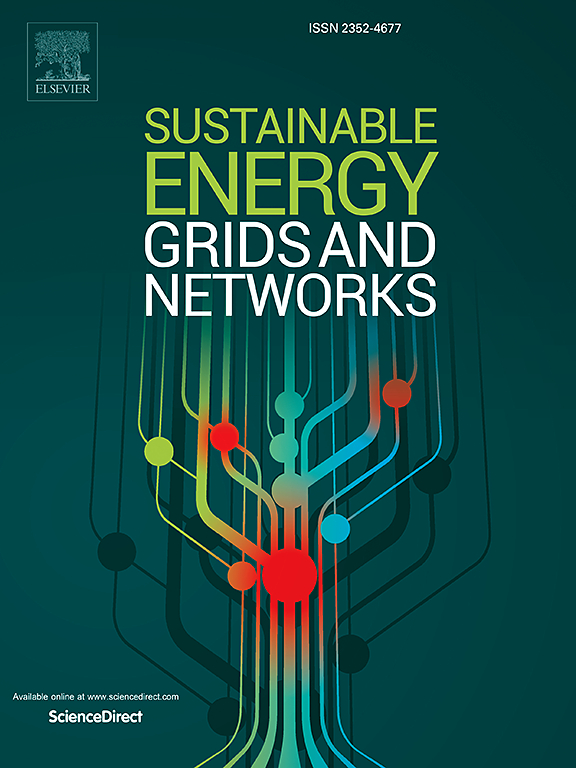考虑拓扑重构的有源配电网灾前分布式鲁棒调度模型
IF 5.6
2区 工程技术
Q2 ENERGY & FUELS
引用次数: 0
摘要
极端自然灾害对利用高比例间歇性可再生能源的配电网络的安全和经济运行提出了特别重大的挑战。然而,尽管拓扑重构被认为是一种理想的方法,以最大限度地提高DNs在紧急情况下快速恢复正常负荷供应的能力,但在以往的研究中,故障发生的随机性和可再生能源输出的不确定性相对被忽视。本文提出了一种灾前分布式鲁棒调度模型,该模型考虑了光伏(PV)和储能系统(ESS)资源高比例的拓扑重构,同时寻求在光伏输出不确定性下协同优化能源、电网、电力负荷和储能系统(即源-网-负荷-储能协调)。该模型是一个两层模型。首先,上层模型采用随机规划的方法,得到灾前预防阶段总调度成本最小的DN拓扑。其次,下层模型基于上层模型给出的DN拓扑,结合光伏输出场景,采用分布式鲁棒优化(distributed robust optimization, DRO)方法对源-负载-存储调度策略进行优化。采用列约束生成算法(C&;CG)解决了DRO问题。最后,以IEEE 33总线系统为例,验证了所提出的双层调度方案在极端天气条件和光伏输出不确定性条件下提高分布式电网负载生存能力的有效性。本文章由计算机程序翻译,如有差异,请以英文原文为准。
Pre-disaster distributionally robust scheduling model for active distribution networks considering topology reconfiguration
Extreme natural disasters represent particularly significant challenges to the safe and economical operation of electric distribution networks (DNs) utilizing a high proportion of intermittent renewable energy. However, although topological reconstruction is regarded as an ideal approach to maximize the capability of DNs in rapidly restoring normal load supply in the face of emergencies, the randomness of fault occurrence and the uncertainty of renewable energy output have been relatively overlooked in previous research. The present work addresses this issue by proposing a pre-disaster distributionally robust scheduling model for active DNs considering topology reconfiguration with a high proportion of photovoltaic (PV) and energy storage system (ESS) resources while seeking to optimize the energy sources, electric power grids, electric loads, and ESSs (i.e., source–grid–load–storage coordination) collaboratively under PV output uncertainty. The model is a two-layer model. First, the upper-layer model aims to obtain the optimal DN topology that minimizes the total dispatch cost in the pre-disaster prevention stage under multiple fault scenarios using stochastic programming. Second, the lower-layer model applies a distributionally robust optimization (DRO) approach to optimize the source–load–storage scheduling strategy based on the DN topology given by the upper layer model, combined with the PV output scenarios. The DRO problem is solved using the column and constraint generation algorithm (C&CG). Finally, the effectiveness of the proposed two-layer scheduling scheme for improving the load survivability of a DN under extreme weather conditions and PV output uncertainties is verified based on the computational results obtained for an IEEE 33-bus system as an example.
求助全文
通过发布文献求助,成功后即可免费获取论文全文。
去求助
来源期刊

Sustainable Energy Grids & Networks
Energy-Energy Engineering and Power Technology
CiteScore
7.90
自引率
13.00%
发文量
206
审稿时长
49 days
期刊介绍:
Sustainable Energy, Grids and Networks (SEGAN)is an international peer-reviewed publication for theoretical and applied research dealing with energy, information grids and power networks, including smart grids from super to micro grid scales. SEGAN welcomes papers describing fundamental advances in mathematical, statistical or computational methods with application to power and energy systems, as well as papers on applications, computation and modeling in the areas of electrical and energy systems with coupled information and communication technologies.
 求助内容:
求助内容: 应助结果提醒方式:
应助结果提醒方式:


